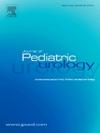对膀胱过度活跃的儿科患者进行骶旁经皮神经电刺激的即时和持续效果
IF 2
3区 医学
Q2 PEDIATRICS
引用次数: 0
摘要
引言 在儿童日间尿失禁的病因中,最常见的是膀胱过度活动症(OAB)。研究设计2013年至2018年期间,在一家中心对57名平均年龄为10.8岁、被诊断患有膀胱过度活动症的儿童进行了前瞻性研究。纳入标准为典型的 OAB 症状。治疗结果根据膀胱日记、48 h 尿频/尿量(48 h F/V)图表和尿流测定法的客观测量结果进行评估。骶旁 TENS 治疗持续了 4 个月,每天两次,每次 1 小时。结果在三个时间点进行评估:结果骶旁 TENS 治疗 4 个月后,白天尿失禁天数从 7.23 天/14 天减少到 3.94 天/14 天(p < 0.05),夜间遗尿从 6.81 天/14 天减少到 3.77 天/14 天(p < 0.05),尿急从 7.36 天/14 天减少到 3.58 天/14 天(p < 0.05)。停止治疗 6 个月后,治疗效果保持稳定,白天尿失禁天数(从 3.94 天[治疗后立即]降至 14 天[停止治疗 6 个月后]的 3.28 天)、夜间遗尿(从 3.77 天降至 14 天的 2.91 天)和尿急发作(从 3.58 天降至 14 天的 2.12 天)(p < 0.05)。在治疗 6 个月后,32% 的日间尿失禁患者、35% 的夜间遗尿患者和 50% 的尿急发作患者出现了完全缓解。在仅对主观症状进行评估的研究中,症状完全缓解的比例较高。我们的研究结果表明,治疗的积极效果持续存在。本研究的优点包括前瞻性设计、样本量大以及在 TENS 治疗前进行统一的标准尿路治疗。4个月的较长疗程可带来更多改善,疗效在停止治疗6个月后保持稳定。有关日间尿失禁、夜间遗尿和尿急发作的治疗结果。空细胞治疗前初始评估pTEN4 个月后pTENS 停止治疗 6 个月后p 日间尿失禁天数/14 天7.23∗3.94∗∗3.28∗∗∗∗vs∗∗p < 0.05∗vs∗∗p < 0.05∗vs∗∗∗.nsDays with nocturnal enuresis/14 days6.81#3.77#2.91####vs##p < 0.05#vs##p < 0.05#vs###.nsDays with urgency episodes/14 days7.36&3.58&&2.12&&&&vs&&p<0.05&vs&&&p<0.05&&vs&&&p<0.05缩写:pTENS,骶旁经皮神经电刺激。本文章由计算机程序翻译,如有差异,请以英文原文为准。
Immediate and continued results of parasacral transcutaneous electrical nerve stimulation in paediatric patients with overactive bladders
Introduction
Among the conditions underlying childhood daytime incontinence the most frequent is overactive bladder (OAB). Parasacral transcutaneous electrical nerve stimulation (parasacral TENS) is a promising therapy for OAB treatment in children; however, there is no standard treatment protocol.
Objective
To evaluate the immediate and continued effects of parasacral TENS monotherapy in children with OAB.
Study design
57 children at mean age 10.8 years diagnosed with OAB at a single centre were prospectively enrolled from 2013 to 2018. The inclusion criterion was typical OAB symptoms. The treatment results were evaluated based on objective measurements from bladder diaries, 48 h frequency/volume (48 h F/V) charts, and uroflowmetry. The parasacral TENS treatment lasted for 4 months, twice daily, with 1 h sessions. Results were evaluated at three time points: 2 months of therapy, 4 months (end of active therapy), and 10 months (6 months after cessation of therapy).
Results
After 4 months of parasacral TENS treatment, the number of days with daytime incontinence decreased from 7.23 to 3.94/14 days (p < 0.05), nocturnal enuresis decreased from 6.81 to 3.77/14 days (p < 0.05), and urgency episodes from 7.36 to 3.58 in 14 days (p < 0.05). Treatment effects remained stable 6 months after therapy cessation regarding days with daytime incontinence (from 3.94 [immediately after treatment] to 3.28 in 14 days [6 months after treatment cessation]), nocturnal enuresis (from 3.77 to 2.91 in 14 days), and urgency episodes (from 3.58 to 2.12 in 14 days) (p < 0.05). Complete response after 6 months of therapy was observed in 32% of patients with daytime incontinence, 35% with nocturnal enuresis, and 50% with urgency episodes.
Discussion
A recent systematic review of parasacral TENS in children with OAB included only two studies with a follow up of 6 months or longer after treatment cessation; therefore, little is known about the continued effects of parasacral TENS. High rates of complete symptom remission were reported in studies where only subjective symptoms were evaluated. Results of our study reveal that the positive effect of treatment persist. The strengths of the present study include its prospective design, large sample size, and uniform standard urotherapy performed prior to TENS.
Conclusions
The use of parasacral TENS in children with OAB is effective and results in a significant reduction in daytime incontinence, nocturnal enuresis, and urgency episodes. A longer treatment duration of 4 months leads to more improvement and the effects remain stable 6 months after treatment cessation.
Summary Table. Treatment results regarding daytime incontinence, nocturnal enuresis, and urgency episodes.
| Empty Cell | Initial evaluation before treatment | After 4 months of pTENS | After 6 months of pTENS cessation | p |
|---|---|---|---|---|
| Days daytime incontinence/14 days | 7.23∗ | 3.94∗∗ | 3.28∗∗∗ | ∗vs∗∗p < 0.05 ∗vs∗∗∗p < 0.05 ∗∗vs∗∗∗.ns |
| Days with nocturnal enuresis/14 days | 6.81# | 3.77## | 2.91### | #vs##p < 0.05 #vs###p < 0.05 ##vs###.ns |
| Days with urgency episodes/14 days | 7.36& | 3.58&& | 2.12&&& | &vs&& p < 0.05 &vs&&&p < 0.05 &&vs&&&p < 0.05 |
Abbreviations: pTENS, parasacral transcutaneous electrical nerve stimulation.
求助全文
通过发布文献求助,成功后即可免费获取论文全文。
去求助
来源期刊

Journal of Pediatric Urology
PEDIATRICS-UROLOGY & NEPHROLOGY
CiteScore
3.70
自引率
15.00%
发文量
330
审稿时长
4-8 weeks
期刊介绍:
The Journal of Pediatric Urology publishes submitted research and clinical articles relating to Pediatric Urology which have been accepted after adequate peer review.
It publishes regular articles that have been submitted after invitation, that cover the curriculum of Pediatric Urology, and enable trainee surgeons to attain theoretical competence of the sub-specialty.
It publishes regular reviews of pediatric urological articles appearing in other journals.
It publishes invited review articles by recognised experts on modern or controversial aspects of the sub-specialty.
It enables any affiliated society to advertise society events or information in the journal without charge and will publish abstracts of papers to be read at society meetings.
 求助内容:
求助内容: 应助结果提醒方式:
应助结果提醒方式:


